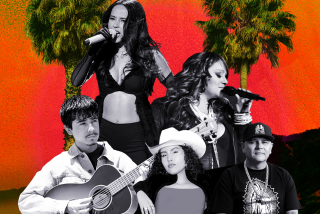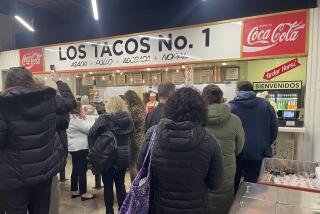Trying to change a bias
- Share via
Black-brown tensions are simultaneously overplayed and understated -- and I’ll explain the paradox with the following embarrassing anecdote.
Years ago, a friend introduced me to an African American writer I had long admired. When we finally met, I tried to greet the guy with a soul handshake: a grip of the palms followed by the clasping of fingers and ending with a gentle knuckle rap. The writer, however, went for a conventional handshake, and his arm went limp when I attempted my dextral gymnastics. We both grimaced.
“He didn’t grow up in the ‘hood, idiot!” my friend yelled at me after the awkward exchange. D’oh! I assumed all black folks greeted each other in that manner. Few black kids attended my overwhelmingly brown elementary, junior and high schools, so I based my actions toward the writer on pop-culture depictions of African Americans. And we all know how accurate those are.
Was I a bigot? No. An ignorant dope? Absolutely. And that’s the lens through which I consider the troubles between African Americans and people of Mexican descent in Southern California over the last couple of years.
There is a problem between the two communities, and the onus falls on us to fix it, as we are the ones taking over black L.A.’s historical role as the most visible and vocal group demanding equality with white Anglos. But the brouhaha isn’t pathological or even permanent.
Unlike most Latin American nations, Mexico doesn’t have a significant Afro-Latino community -- about 1.5%, according to Mexican government figures. As a result, Afro-Mexicans don’t experience ruthless discrimination from the population at large so much as a patronizing attitude that treats them as perpetual negritos -- harmless, somewhat amusing “darkies.”
Most of the popular depictions of Afro-Mexicans I grew up with -- Memin Pinguin, the lovable, dark-skinned comic-book character who looks like an ape, or the black characters on telenovelas or films -- made Stepin Fetchit seem as dignified as Cornel West. When Mexicans migrate to the United States and interact with African Americans, their attitudes toward blacks therefore ensure some degree of cultural misunderstanding. And it’s from this dehumanizing bias that Mexican gang members justify their hate for innocent blacks.
But I’m optimistic. We must place such clashes in their historical context. Assimilation in America isn’t pretty -- witness Chicago’s ethnic wards, or “Gangs of New York.” But it happens eventually. Think of how black culture has become part of Mexican culture. America’s favorite Mexican song, “La Bamba,” is the signature tune of son jarocho, a musical form created by African slaves and indigenous tribes in the southern Mexican state of Veracruz whose rolling rhythms heavily influenced mariachi. One of mariachi’s most famous melodies, “El Son de La Negra” (Mexicans will know it by its opening, lilting trumpets and looping guitar strums), translates as “The Song of the Black Lady.” And all Mexican parties eventually feature cumbias, the slow, tropical dances of Colombia that emerged from the country’s rich African heritage.
In the States, the predominant audience for Los Angeles’ nearly forgotten R&B; oldies artists like Brenton Wood and the Penguins are second- and-third generation Chicanos. Mexicans cheer on the Lakers and tune in to KPWR-FM (105.9) morning-show host Big Boy. Even less-assimilated young Mexicans get into the mixing of cultures by grafting Mexican regional music like banda (brass bands) and conjunto norteno (the one with accordions) onto hip-hop beats to create a future everyone can live with and shimmy to.
Over a decade ago, Tupac Shakur wondered, “Would it be L.A. without Mexicans?” and urged solidarity between black and brown. Nowadays, whenever I hear Tupac blasted from rattling SUVs, it’s usually by a Mexican. We learn. We assimilate. The road to racial harmony between the two groups isn’t pretty -- wasn’t I dumb for my soul shake? -- but it’s a road, not a wall.



